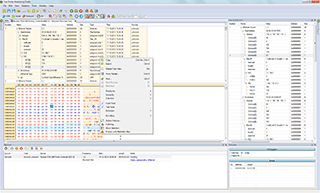Breaking News
Main Menu
Black And White 2 Fixed Aging Crackle
суббота 16 февраля admin 47
In the approach, bit-serial arithmetic and a scheduling method that decouples the sample period from the scheduling period are used. Bit serial arithmetic in dsp 3. ECEn 621 Computer Arithmetic Dr. Doran Wilde Bit-Serial Multipliers Winter 2006 Slide #6 ECEn 621 Computer Arithmetic Dr. Doran Wilde Dependence Graphs and Regular Array Design Show all operations and use arrows to show flow of data between operations. Shows dependences between operations. Determine a schedule. BIT-SERIAL ARITHMETIC Bit-Serial Addition and Subtraction X = x 0 ∑ x 1 x 2 x Wd –1 Y = y 0 ∑ y 1 y 2 y Wd –1 MSB LSB LSB first is commonly used The MSB first case is more difficult, but it is sometimes used D D X Y DC Reset Set X Sum DiffY D C FA DSP Integrated Circuits Department of Electrical Engineering larsw@isy.liu.se. All computers before 1951, and most of the early massive parallel processing machines used a bit-serial architecture—they were serial computers. Bit-serial architectures were developed for digital signal processing in the 1960s through 1980s, including efficient structures for bit-serial multiplication and accumulation.
FINE ANTIQUE CHINESE BLACK AND WHITE PORCELAIN TEA JAR RARE. Was fixed after brake but can be repaired with much better result if desired. 2.7lb Old Chinese.
PC GAME FIXES Black And White 2 for related No-CD & No-DVD Patch No-CD & No-DVD Patch troubleshooting: The most common problem getting a No-CD/No-DVD patch to work is ensuring that the No-CD/No-DVD patch matches you're game version, because the games exe is changed when a patch update is applied previous versions won't work. If its an older game you are playing and you are running Windows 7 or Windows 8 it may not work, if you right click the.exe file and choose Properties and then Compatibility you can change this to run in Windows 98/ Windows 2000 etc. You can find more information on the Beginners Help page.
Riveted Caughley Tea bowl, circa 1799 Illustration of 'foot rim' on back of plate Rim chip, an item in 'as is' condition Factory stamp and Impressed marks Stilt marks or kiln spurs and factory ink stamp Kiln split on interior of soup tureen bottom When grading or describing the condition of an item, the main thing for a seller to do is to be as honest as possible in describing the condition to the best of his or her ability. This would be a good start. Always remember that you do want your customer to be pleased and have no sudden surprises or misleading conditional descriptions. GRADING CHINAWARE When trying to grade or describe the condition of the various types of chinaware, e.g. Porcelain, bone china and pottery, there are some basic prerequisites about the process of china manufacturing necessary to know that the untrained or unknowledgable may consider as damage, for example: stilt marks, glaze slips, transfer slips, kiln sags, kiln splits, underglaze gritand other terminologies. As we proceed to explain these terminologies we will afterwords know that some of these conditions are acceptable and expected conditions for many antique pieces of china that were made prior circa 1900 when kilns were heated by coal and wood.  The potters pre-heated the ovens/kilns for several weeks prior to firing and glazing.
The potters pre-heated the ovens/kilns for several weeks prior to firing and glazing.
Consequently once the kiln heat reached a certain consistent temperature, the potters tried to maintain this desired temperature so as to prevent some defects from occurring as a result of under-heating temperature or over-heating temperature in the kiln. After circa 1900 ovens/kilns were gas and electrically heated; consequently china pieces had less factory defects because temperatures could be raised and maintained more accurately. Unlike grading coins, the grading of chinaware, furniture, glassware and metal-wares is quite different.

Some basic terms applicable to chinaware which are necessary to know when purchasing china are as follows. These conditions that commonly occurred during the manufacturing process are considered acceptable and are not considered as damage rather the standard occurrence in the whole process of china manufacture from beginning to end. • Stilt mark • Pontiff mark • Glaze slip • Transfer slip • Kiln sag • Kiln crack or Kiln split • Peppering or Underglaze grit These terminologies above are explained below once we have sorted through the various explanations of condition or grading of chinaware. Mint condition Mint condition usually implies that a particular piece of chinaware, metal-ware, glassware and furniture is in as made or like new condition. When using the description terminology mint condition, items should always be free of chips, cracks, repairs, or similar damage or wear.
